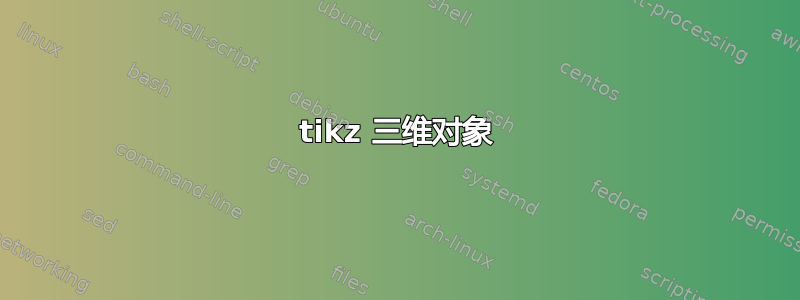
下一个代码可以绘制为三维对象吗
{
\begin{minipage}[c]{.7\textwidth}
\vskip -15.cm
{
\begin{tikzpicture}
\draw [thin,orange,fill=yellow]
(.25,.25) -- (.25,0) -- (.5,0) -- (.5,.25) -- (.75,.25) -- (.75,.5) -- (.5,.5) -- (.5,.75) -- (.25,.75) -- (.25,.5) -- (0,.5) --
(0,.25) -- cycle ;
\end{tikzpicture}
\vskip -.7cm
\hskip -.06cm
{{\textcolor{red}{{\huge{\textbf{{Na}}}}}}}
}
\end{minipage}
}
答案1
像这样吗?
或这个?
或这个?
\documentclass[tikz,border=10pt,multi]{standalone}
\usetikzlibrary{backgrounds}
\begin{document}
\newlength\cw
\setlength\cw{2.5mm}
\begin{tikzpicture}
\draw [thin, orange, fill=yellow]
(-.5\cw,.5\cw) |- ++(\cw,\cw) coordinate [midway] (a) coordinate (b) |- ++(\cw,-\cw) coordinate [midway] (c) coordinate (d) |- ++(-\cw,-\cw) coordinate [midway] (e) coordinate (f) |- ++(-\cw,-\cw) coordinate [midway] (g) coordinate (h) |- ++(-\cw,\cw) coordinate [midway] (i) coordinate (j) |- coordinate [midway] (k) cyclecoordinate (l);
\foreach \i in {a,b,...,l}
{
\coordinate (\i 1) at ([xshift=.25\cw,yshift=.25\cw]\i);
% \node [font=\tiny] at (\i 1) {\i};
}
\begin{scope}[on background layer]
\path [fill=yellow] (a) -- (a1) -- (b1) -- (c1) -- (d1) -- (e1) -- (e) |- (c) |- cycle (k) -- (k1) -- (a |- k1) |- cycle (g) -- (g1) |- (f) -- cycle;
\foreach \i in {a,b,c,d,e,k,g} \draw [thin, orange] (\i) -- (\i 1);
\draw [thin, orange] (a1) -| (c1) -| (e1) (k1) -- (k1 -| a) (g1) -- (g1 |- f);
\end{scope}
\node [text=red, font=\huge\bfseries, anchor=center, yshift=.5\cw, xshift=.125\cw] at (0,0) {Na};
\end{tikzpicture}
\begin{tikzpicture}
\draw [thin, orange, fill=yellow]
(-.5\cw,.5\cw) |- ++(\cw,\cw) coordinate [midway] (a) coordinate (b) |- ++(\cw,-\cw) coordinate [midway] (c) coordinate (d) |- ++(-\cw,-\cw) coordinate [midway] (e) coordinate (f) |- ++(-\cw,-\cw) coordinate [midway] (g) coordinate (h) |- ++(-\cw,\cw) coordinate [midway] (i) coordinate (j) |- coordinate [midway] (k) cyclecoordinate (l);
\foreach \i in {a,b,...,l}
{
\coordinate (\i 1) at ([xshift=.25\cw,yshift=.25\cw]\i);
% \node [font=\tiny] at (\i 1) {\i};
}
\begin{scope}[on background layer]
\path [fill=yellow] (a) -- (a1) -- (b1) -- (c1) -- (d1) -- (e1) -- (e) |- (c) |- cycle (k) -- (k1) -- (a |- k1) |- cycle (g) -- (g1) |- (f) -- cycle;
\foreach \i in {a,b,c,d,e,k,g} \draw [thin, orange] (\i) -- (\i 1);
\draw [thin, orange] (a1) -| (c1) -| (e1) (k1) -- (k1 -| a) (g1) -- (g1 |- f);
\end{scope}
\foreach \i [evaluate=\i as \j using 100-100*\i] in {.25,.245,...,0}
\node [text=red!\j!black, font=\huge\bfseries, anchor=center, yshift=.475\cw+\i\cw, xshift=-.125\cw+\i\cw] at (0,0) {Na};
\end{tikzpicture}
\begin{tikzpicture}
\foreach \i [evaluate=\i as \j using 50-200*\i] in {.25,.245,...,0}
\filldraw [yellow!\j!orange]
(-.5\cw+\i\cw,.5\cw+\i\cw) |- ++(\cw,\cw) |- ++(\cw,-\cw) |- ++(-\cw,-\cw) |- ++(-\cw,-\cw) |- ++(-\cw,\cw) |- cycle;
\draw [thin, draw=yellow!50!orange, fill=yellow]
(-.5\cw,.5\cw) |- ++(\cw,\cw) coordinate [midway] (a) coordinate (b) |- ++(\cw,-\cw) coordinate [midway] (c) coordinate (d) |- ++(-\cw,-\cw) coordinate [midway] (e) coordinate (f) |- ++(-\cw,-\cw) coordinate [midway] (g) coordinate (h) |- ++(-\cw,\cw) coordinate [midway] (i) coordinate (j) |- coordinate [midway] (k) cycle coordinate (l);
\foreach \i [evaluate=\i as \j using 100-100*\i] in {.25,.245,...,0}
\node [text=red!\j!black, font=\huge\bfseries, anchor=center, yshift=.475\cw+\i\cw, xshift=-.125\cw+\i\cw] at (0,0) {Na};
\end{tikzpicture}
\end{document}





